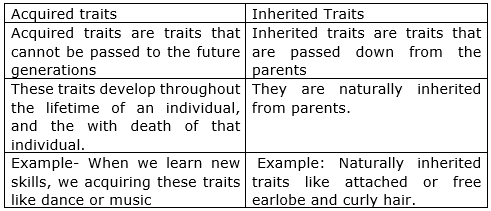Distinguish between the acquired traits and the inherited traits in tabular form, giving one example for each.
OR
Explain with the help of example each, how the following provide evidences in favour of evolution:
i. Homologous organs
ii. Analogous organs
iii. Fossils

OR
i. Organs having a common underlying anatomy that was present in their last common ancestors are called homologous organs. (homo : same logy : structure)
Evidences: bat's wing, wings of birds, seal’s flipper, forelimb of a horse, and human arm. They have the same bone structure with radius, ulna, carpals, metacarpals and phalanges. But they have different functions like swimming and flying.
ii. Analogous organs are the opposite of homologous organs, which have similar functions but different origins. (Ana: different logy: structure)
Evidences: wings of insects, bats and birds. All of them are used for flying but are made of different structures. Like the wings of insects are made of chitin(a polysaccharide) and the birds have their wings made of a bony skeleton. Structures are all different but the function is same-flight.
iii.Preserved traces of living organisms in rocks and soil are called fossils. They tell about the age of the animal.
Evidences: A dinosaur skull fossil was found a few years ago in the Narmada valley. This shows that dinosaurs did exist.